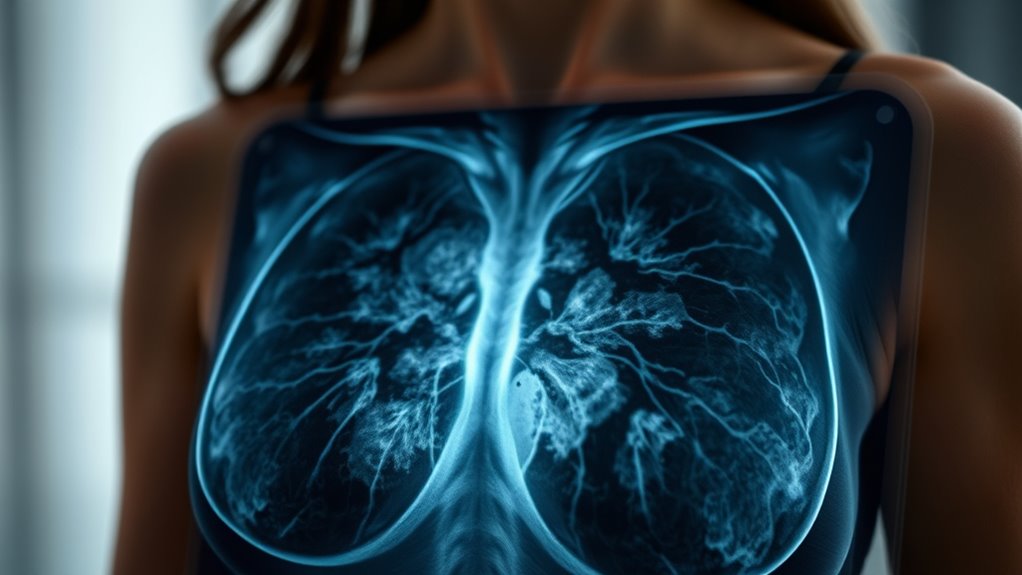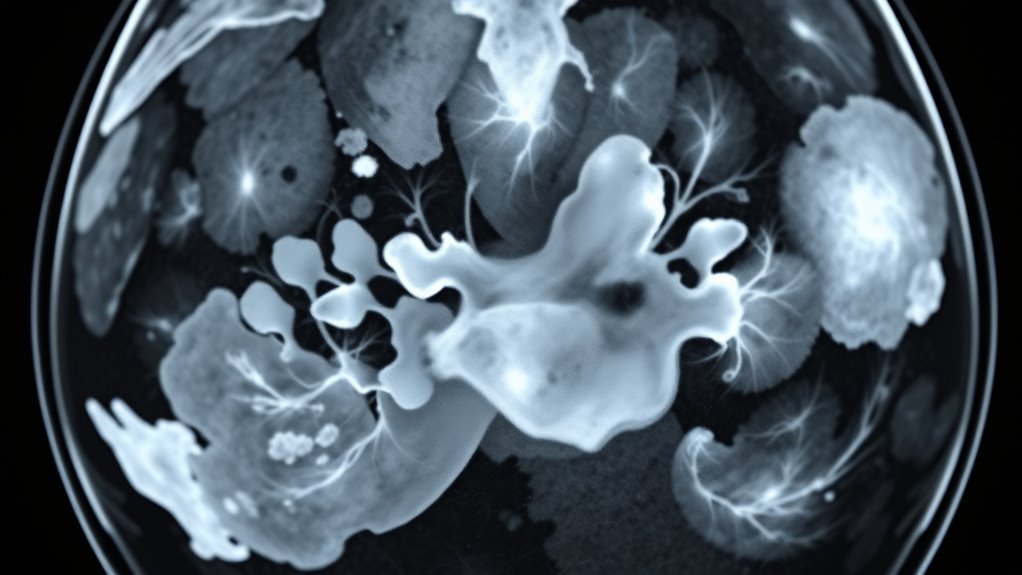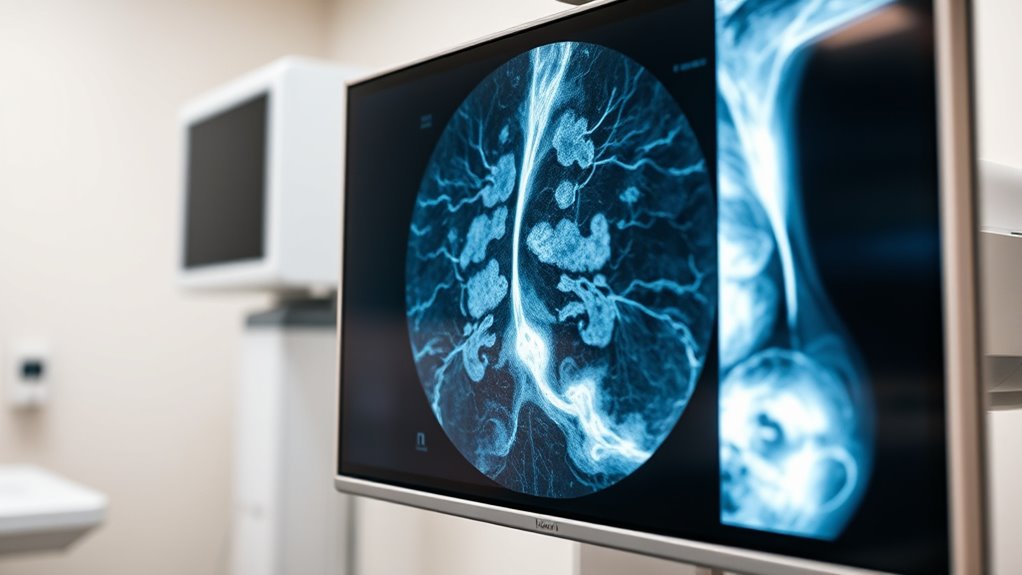Breast density can considerably lower mammography sensitivity, making it harder to spot tumors because dense tissue appears white like abnormalities. This masking effect increases the chance of missed cancers and false negatives. If you have dense breasts, standard mammograms may not always be enough, and additional imaging options like ultrasound or MRI could help. Want to understand how new technologies and strategies can improve detection despite dense tissue? Keep exploring for more details.
Key Takeaways
- Increased breast density reduces mammography sensitivity by masking tumors with dense tissue, making detection more difficult.
- Dense tissue appears white on mammograms, similar to tumors, leading to higher false negatives.
- The sensitivity of mammography is highest in fatty breasts and decreases as breast density increases.
- Supplementary imaging methods like ultrasound or MRI improve detection in women with dense breasts.
- Accurate assessment of breast density helps tailor screening strategies to improve mammography sensitivity.
Understanding Breast Density and Its Classifications

Have you ever wondered why some mammograms are harder to interpret than others? Your breast density depends on factors like genetic influences and hormonal levels. Genetics play a role by determining how much connective tissue, fat, and glandular tissue you have, affecting the density classification. Hormonal influences, especially fluctuations in estrogen and progesterone, can increase glandular tissue, making your breasts denser at certain times. Breast density is classified into four categories, from almost entirely fatty to extremely dense tissue. Higher density not only complicates image interpretation but also relates to increased breast cancer risk. Breast tissue composition significantly impacts mammogram clarity and interpretation. Additionally, understanding how hormonal fluctuations influence density can help you plan the best times for screening. Recognizing how breast density classifications are determined can assist in understanding the limitations of mammography and the potential need for supplemental imaging. Understanding these classifications helps you and your healthcare provider better assess your mammogram results and determine if additional screening might be beneficial.
How Dense Tissue Affects Mammogram Imaging

Dense breast tissue can considerably impact the quality of mammogram images because it appears white on the scan, just like potential abnormalities such as tumors. This white tissue composition creates areas of overlapping tissue that can obscure or mimic abnormalities, making it harder to distinguish true signs of concern. As a result, mammogram clarity diminishes in dense breasts, reducing the effectiveness of detection. The dense tissue’s similarity in appearance to tumors means that small or subtle abnormalities may go unnoticed. Your ability to interpret mammogram results depends on how well the images reveal differences between normal tissue and potential issues. When tissue composition is dense, it challenges radiologists to identify abnormalities accurately, impacting overall screening effectiveness.
The Impact of Breast Density on Cancer Detection Rates

High breast density can hide tumors on mammograms, making them harder to detect. As a result, cancer detection rates drop in women with dense tissue. Understanding this impact is key to improving screening effectiveness. Data privacy challenges can also influence how individuals perceive the importance of early detection. Additionally, advancements in AI-enhanced imaging techniques are being developed to help overcome these challenges.
Dense Tissue Obscures Tumors
Why does breast density pose such a challenge in cancer detection? Dense tissue appears white on mammograms, just like tumors, making it hard to distinguish between healthy tissue and cancerous growths. This masking effect reduces the sensitivity of mammograms, which can lead to missed diagnoses. Your genetic factors and lifestyle influences play a role in determining breast density; for example, genetics can predispose you to denser breasts, while factors like age, hormone use, and body weight also impact tissue composition. When tissue is dense, tumors can hide within the fibroglandular tissue, making detection more difficult. Additionally, ongoing research into AI security highlights the importance of developing robust safety measures to ensure the reliability of diagnostic tools. Understanding how these factors influence breast density helps explain why some women experience reduced mammogram effectiveness and highlights the importance of tailored screening approaches.
Reduced Mammogram Effectiveness
Breast density can considerably reduce the effectiveness of mammograms in detecting cancer. Dense breast tissue appears white on a mammogram, similar to tumors, which makes it difficult to distinguish abnormalities. This similarity creates significant mammogram limitations, especially in women with high breast density. As a result, cancers may go unnoticed, lowering detection rates and delaying diagnosis. You might think a clear mammogram means you’re cancer-free, but dense tissue can mask tumors, giving a false sense of security. Increased breast density directly impacts mammogram sensitivity, meaning you may need additional screening methods like ultrasound or MRI for accurate detection. Recognizing these limitations helps you understand why some cancers are missed and highlights the importance of tailored screening strategies for women with dense breasts.
Challenges Faced by Radiologists When Interpreting Dense Breasts

When interpreting dense breasts, you often face confusion from overlapping tissue that can hide abnormalities. This makes identifying potential malignancies more difficult and increases the chance of missed diagnoses. Additionally, the variability in breast density among patients adds to the challenge of accurate interpretation. Recognizing air quality factors can sometimes provide comfort and familiarity in stressful diagnostic situations.
Overlapping Tissue Confusion
Interpreting mammograms of dense breasts presents a significant challenge because overlapping tissue can obscure or mimic abnormalities. Dense tissue, often influenced by genetic factors and hormonal influences, creates complex patterns that make distinguishing normal from suspicious areas difficult. These overlapping structures can hide small tumors, reducing visibility and increasing false negatives. Hormonal fluctuations, such as those during pregnancy or hormone therapy, can increase tissue density, further complicating interpretation. Genetic predispositions may also lead to naturally denser breasts, making it harder to detect early signs of cancer. Additionally, the high contrast ratios in imaging can be affected by dense tissue, impacting the overall clarity of the mammogram. As a radiologist, you must carefully analyze these overlapping patterns to avoid misdiagnosis. Understanding the influence of genetics and hormones on tissue density helps you stay alert to potential blind spots in dense breast imaging.
Masked Malignancies Challenges
Overlapping tissue in dense breasts often creates areas that resemble malignancies or hide actual tumors, making detection particularly challenging. This masking effect complicates interpretation, increasing false negatives. Factors like genetic predisposition and lifestyle influences can affect breast density, further obscuring malignancies. To navigate these challenges, radiologists focus on:
- Recognizing subtle differences in tissue patterns that may indicate malignancy.
- Incorporating additional imaging methods, such as ultrasound or MRI, for clearer assessment.
- Considering patient history, including genetic factors and lifestyle influences, to evaluate risk more accurately.
- Utilizing expert voice actors to effectively communicate complex medical information and improve patient understanding.
- Recognizing that breast tissue composition impacts the interaction with imaging techniques, making interpretation even more nuanced. Additionally, understanding how breast density influences the accuracy of mammography can help reduce missed diagnoses and improve detection rates.
Understanding how dense tissue interacts with these factors helps you better interpret mammograms and reduces missed diagnoses, despite the inherent masking challenges.
Variability in Density
Variability in breast density presents a significant challenge for radiologists because dense tissue can differ widely among patients, affecting the clarity of mammogram images. Genetic factors play a role, influencing whether someone has naturally dense breasts, while hormonal influences, such as age, pregnancy, and hormone therapy, can cause fluctuations in density over time. This variability makes it harder to distinguish abnormal from normal tissue, especially when density is high. Some women may have consistently dense breasts, complicating detection, while others experience changes in density that require careful interpretation. Understanding these individual differences helps radiologists decide when additional imaging is needed. Recognizing how genetic and hormonal factors contribute to density variability is key to improving diagnostic accuracy and patient outcomes.
Methods for Assessing and Communicating Breast Density

Evaluating and communicating breast density is essential for effective breast cancer screening and risk management. To do this, you first assess breast tissue composition, often using visual or automated methods. These include:
Assessing breast density is vital for accurate screening and risk management.
- BI-RADS categories, which classify density into four levels, aiding consistent communication.
- Automated volumetric tools, providing objective measurements that enhance mammogram accuracy.
- Clear reporting, ensuring patients understand their density status and its implications.
Alternative Screening Techniques for Women With Dense Breasts

For women with dense breasts, traditional mammography may not be enough to catch all abnormalities, so exploring alternative screening options is essential. Techniques like ultrasound or MRI can provide additional detail, especially when dense tissue obscures tumors. Your genetic factors may predispose you to higher breast density, making these alternatives more valuable. Lifestyle influences, such as diet or hormonal factors, also impact breast tissue composition, further affecting detection sensitivity. These factors highlight the importance of personalized screening strategies. While mammography remains the primary tool, combining it with other methods can improve early detection. Consulting your healthcare provider about your breast density, genetic background, and lifestyle can help determine the most effective, tailored screening approach for you. Recognizing breast tissue composition can guide more accurate and effective screening choices.
Advances in Imaging Technology to Improve Detection

Recent advances in imaging technology have markedly enhanced our ability to detect breast cancer early, especially in women with dense breast tissue. Techniques like digital breast tomosynthesis (3D mammography), contrast-enhanced spectral mammography, and molecular imaging provide clearer, more detailed views. These innovations account for genetic factors and lifestyle influences that affect breast tissue composition. To maximize detection, consider:
- Utilizing 3D imaging for better visualization of dense tissue.
- Combining imaging methods tailored to your risk profile.
- Staying informed about new technologies that adapt to genetic and lifestyle factors.
- Understanding how breast tissue composition influences screening effectiveness and the importance of personalized approaches.
Additionally, emerging imaging biomarkers may further improve specificity and reduce false positives in dense breast tissue screening. Advances in imaging technology also include improvements in image processing algorithms that enhance clarity and diagnostic accuracy. These advancements help overcome limitations posed by dense tissue, leading to earlier diagnosis and improved outcomes. Staying proactive and discussing these options with your healthcare provider ensures you’re leveraging the latest tools for effective screening.
Policy Changes and Legislation Regarding Breast Density Disclosure

Legislation requiring breast density disclosure has gained momentum across many regions, aiming to inform women about their breast tissue composition and its implications for cancer detection. These legal mandates recognize patient rights to know their breast density, empowering you to make informed decisions about screening options. By understanding your breast density, you can advocate for personalized care and discuss additional screening methods with your provider. The table below highlights emotional aspects of these laws:
| Impact on Women | Emotional Response |
|---|---|
| Increased awareness | Feeling empowered or anxious |
| Better informed choices | Hope for early detection or fear of missed cancers |
| Personal health control | Confidence or uncertainty |
| Advocacy for your health | Strength or vulnerability |
These policies aim to support your health journey through transparency and education. Additionally, understanding the medical implications of breast density can help you better grasp the importance of tailored screening strategies.
Strategies for Women to Optimize Their Breast Cancer Screening

To maximize the effectiveness of your breast cancer screening, you should adopt proactive strategies that improve detection and guarantee personalized care. First, understand your genetic risk by discussing family history with your doctor, which can influence screening options. Second, consider lifestyle factors like diet, exercise, and alcohol consumption, as they impact your overall risk. Third, stay informed about breast density and advocate for additional imaging, such as ultrasound or MRI, if recommended. Regular self-exams and prompt reporting of any changes are essential. Additionally, being aware of the different breast tissue types can help you understand how density may affect mammogram sensitivity. Recognizing modern toilet technology, such as dual-flush systems, underscores the importance of proactive maintenance and proper disposal practices to ensure efficiency and longevity. Understanding digital literacy and how it influences health information can empower you to make better screening decisions. Combining awareness of genetic and lifestyle risks with personalized screening plans helps detect cancer early and increases your chances of successful treatment. Being proactive guarantees you get the most accurate, tailored approach to your breast health.
Frequently Asked Questions
How Does Breast Density Change Over a Woman’S Lifetime?
As you age, your breast density can change due to hormonal fluctuations and genetic factors. During your reproductive years, hormones increase breast tissue, making your breasts denser. After menopause, hormone levels drop, usually leading to less dense breast tissue. Genetics also influence these changes, so if dense breasts run in your family, you might experience higher density for longer. Overall, breast density varies throughout your lifetime, reflecting hormonal and genetic influences.
Are There Specific Risk Factors Associated With Dense Breasts?
You might notice certain factors subtly raise your chances of having denser breast tissue. Hormonal influences, like those from your menstrual cycle or hormone therapy, can play a role. Additionally, your genetic predisposition influences your breast composition. While these factors don’t guarantee density, being aware of them helps you stay proactive about your breast health. Regular screenings and discussions with your healthcare provider ensure you’re well-informed and supported.
Can Lifestyle Modifications Reduce Breast Density?
You might wonder if lifestyle modifications can lower breast density. While some lifestyle choices, like maintaining a healthy weight, reducing alcohol intake, and regular exercise, can influence hormonal impact and overall breast health, they may not considerably decrease density itself. A balanced lifestyle supports your hormonal balance, which can positively affect breast tissue. However, consult your healthcare provider for personalized advice, as genetics and hormonal factors play a major role.
How Accurate Are Alternative Screening Methods Compared to Mammography?
While traditional mammography remains the standard, alternative methods like 3D imaging and AI analysis offer improved accuracy, especially for dense breasts. These advanced techniques can detect abnormalities more clearly and reduce false positives. However, they’re still evolving and may not yet replace mammography entirely. You should consider combining these methods for better screening outcomes, but consult your healthcare provider to tailor the approach to your specific needs.
What Are Upcoming Innovations in Breast Imaging Technology?
Upcoming innovations in breast imaging include 3D imaging techniques that provide more detailed, layered views, improving detection accuracy. Molecular imaging is also advancing, allowing you to see cellular activity and identify cancer at earlier stages. These technologies aim to enhance early diagnosis and reduce false positives, giving you more precise and personalized screening options. As these innovations develop, they promise to transform how you and your healthcare provider monitor breast health.
Conclusion
So, next time your mammogram comes back with that confusing “dense” label, remember—it’s not just a beauty contest. Your breasts might be hiding more than just confidence; they could be concealing cancer too. Stay informed, ask questions, and consider newer screenings. After all, if your dense tissue can outsmart the imaging tech, maybe it’s time to outsmart it back. Because in the game of hide-and-seek, knowledge is your best armor.








